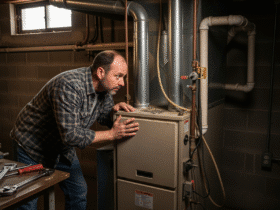Key Takeaways
- Strategic preparation before air conditioning installation reduces surprises and disruptions.
- Choosing an appropriately sized air conditioning (AC) system leads to greater comfort and improved energy efficiency.
- Ongoing maintenance after installation is essential for long-term system health.
- Reliable installation practices can minimize energy bills and improve indoor air quality.
- Verifying technician credentials protects your investment and peace of mind.
How AC Installation Affects Comfort and Efficiency
Adding a new air conditioner to your home isn’t simply about upgrading your appliances—it’s about creating a comfortable environment that helps your family thrive. The installation process is a big factor in how evenly and effectively your system cools each room. If an AC unit is installed improperly, you’ll likely feel the results immediately: inconsistent temperatures, increased humidity, and even escalating utility bills. Those who turn to expert AC installation Oak Harbor often notice a difference in their home’s climate sooner, as these professionals pay extra attention to every installation detail.
According to the U.S. Department of Energy, a poorly installed system can reduce energy efficiency by up to 30%. That equates to more money spent on keeping your home at the right temperature and a greater risk of HVAC breakdowns during hot spells. High-quality installations yield predictable comfort and noticeable energy savings, resulting in both a pleasant indoor experience and long-term financial benefits.
Key Preparation Steps for Homeowners
The groundwork for a pain-free installation begins well before the technicians arrive at your door. Taking time to clear pathways and remove fragile decor or bulky furniture isn’t just about making space—it’s about keeping your belongings safe and creating an obstacle-free work environment for your installation team. It can prevent unfortunate accidents and significantly streamline the installation process.
- Move large or delicate items away from access points, including hallways, vents, and the installation area.
- Have a conversation with your installer about thermostat positioning to ensure it’s in a convenient and optimal spot for temperature readings.
- Test household power outlets and check the circuit breaker to ensure everything is compatible with the new AC unit’s requirements. Upgrading your home’s electrical system beforehand, if needed, can spare you headaches later.
Simple preparation like this not only helps keep your installation on track but can also reduce the overall project timeline, allowing you to enjoy your new cooling system even sooner.
Choosing the Best AC System for Your Space
Choosing the right air conditioning (AC) system is one of the most critical decisions homeowners must make to ensure comfort and efficiency in their living spaces. It’s essential to understand that both oversized and undersized units can lead to various issues such as uneven temperatures—resulting in hot and cold spots—and can significantly shorten the system’s lifespan due to increased wear and tear. To avoid these complications, professionals typically conduct a comprehensive assessment that evaluates several factors, including the home’s insulation quality, square footage, window positioning, and occupancy patterns, before making system recommendations.
There is a diverse range of AC systems available, including central AC systems, ductless mini-splits, and high-efficiency variable-speed units, all of which cater to eco-conscious homeowners. Although high-efficiency models may demand a higher initial investment, they can substantially lower monthly energy bills over time and enhance the property’s overall value. For homeowners seeking to navigate these numerous options, resources like Consumer Reports’ AC buying guide are invaluable, providing detailed analyses of critical ratings, features, and maintenance requirements to empower informed choices.
Moreover, selecting the appropriate AC system is not solely about immediate comfort; it also involves future-proofing the home. Opting for systems equipped with modern refrigerants that comply with current environmental standards, along with securing a robust manufacturer’s warranty, is a prudent strategy that can yield long-term benefits. This approach ensures reliability, energy efficiency, and peace of mind for years to come.
What to Expect During the Installation Process
On the day your installers arrive, prepare for a dynamic mix of excitement and activity as a critical home improvement project begins. The installation process typically starts with a detailed walkthrough of your home, allowing the professionals to identify and mark locations for the removal of old heating and cooling units, as well as insulation. Experienced and licensed installers come equipped with specialized materials such as drop cloths, blankets, and protective runners, which serve to protect your flooring and walls from potential damage during the installation process.
Once a safe workspace is established, the installation team will carefully dismantle any existing units, disconnecting power supplies as necessary to ensure the safety of the work area. Following this, they will conduct a thorough inspection of the ductwork for any leaks or signs of damage, sealing any vulnerabilities discovered to enhance the overall efficiency of your new system. After the new AC unit is installed, technicians perform a series of rigorous tests designed to confirm strong airflow, optimal cooling capacity, and the reliable functioning of the thermostat.
Before concluding their work, the team will review essential maintenance procedures with you, addressing any questions you may have to help you understand how to care for your new system. It’s worth noting that for most homes, the entire transition to a new air conditioning system can be accomplished within a single day, resulting in only minor disruptions to your daily routines. This seamless process not only ensures quick installation but also provides efficient climate control for years to come.
Smart Questions to Ask Your Installer
No matter how straightforward an installation might seem, asking thoughtful questions can go a long way toward future satisfaction. Open communication ensures any unique needs are addressed, and it helps prevent future confusion about system operation. Some top questions to consider:
- What kind of reduction in energy usage can I expect from this new system compared to my previous setup?
- Will my electrical panel or wiring need to be updated to support my new AC unit safely?
- Can you walk me through a simple maintenance routine, such as changing filters and cleaning vents?
- What should I do if I notice problems like unusual noises or temperature swings?
- What are the specific terms of the manufacturer’s warranty, and does it require regular professional servicing?
Professional installers should be willing to answer these questions. Their guidance will help you feel confident in using your new AC system and keeping it running at its best for years to come.
Post-Installation: Ensuring Optimal Performance
Installation is just the beginning—your new air conditioning system requires dedicated attention and consistent care to operate at its absolute best year after year. During the crucial initial week following installation, make it a priority to observe how quickly your home cools down and whether you notice any unusual noises or airflow issues that could indicate potential problems. Most manufacturers recommend scheduling a follow-up maintenance visit within the first twelve months of installation to ensure everything is functioning correctly. Regular professional checkups play a vital role in keeping your air conditioner running at peak efficiency. By scheduling these necessary service appointments proactively, you can prevent minor issues from escalating into costly repairs down the line, which could disrupt your comfort and budget.
Common Mistakes to Avoid
When installing a brand new air conditioning (AC) system, various types of mistakes can be made, some of which are more common—and significantly more costly—than others. One major error is hiring the lowest-cost installer available without taking the essential steps to verify proper licensing and insurance. This oversight can result in subpar workmanship, which not only shortens the lifespan of your brand-new system but also creates potential safety hazards or serious code compliance issues within your home. As a best practice, always confirm that your installation team boasts strong, positive reviews from previous clients and possesses the necessary certifications for the job to ensure that quality service and safety standards are upheld.
Another frequent oversight made by homeowners is the failure to adequately prepare their home for the installation day. Leaving clutter, debris, or fragile items in the workspace can add unnecessary hurdles for the installation team and may even cause delays in completing the project on time. Taking even small proactive steps ahead of time, such as clearing the area, can go a long way toward ensuring a smoother, more efficient, and faster experience for everyone involved.
Reliable AC Installation Sets the Tone for Every Season
Investing in a professional air conditioning installation is about so much more than mere comfort and convenience within your home. It can significantly help safeguard your family’s health by improving overall indoor air quality and enhancing humidity control, which is crucial for preventing mold and other allergens. This investment can also increase your home’s overall value in the real estate market and slash your energy bills by optimizing energy efficiency. By meticulously following the right preparation steps, selecting a system that perfectly fits your unique space and needs, and collaborating with a team known for their expert AC installation services in Oak Harbor, you effectively set a strong foundation for cool, enjoyable, and stress-free summers, as well as a home that is built to last well into the future.
Whether you’re preparing for the installation of your very first air conditioning system or updating an old favorite unit, turning to reliable resources like the U.S. Department of Energy and Consumer Reports’ comprehensive AC buying guide can equip you with invaluable knowledge that ensures your investment pays off in the long run. Coupling that knowledge with trusted local expertise and committing to routine upkeep, maintenance, and inspections, you can enjoy a consistently refreshing indoor climate control experience all year long, regardless of how high the temperature soars outside during those hot summer months.








